The bitwise operator has already been explained quite a few times already. Let's say that buffer[0] contains 1, buffer[1] contains 2 and index is 0 and replace these values:
short sample = (short)((buffer[1] << 8) | buffer[0]);
short sample = (short)((1 << 8) | 2);
Now, a semi-graphical representation. This is the numeral 1 in a binary representation:
0000 0001
Shifting eight positions to the left would make this number to "overflow" from a single byte. However, the compiler is smart enough to give us more room.
0000 0001 0000 0000
Now, the right part: the number 2 looks like this in binary:
0000 0010
And the "|" operator (bitwise OR) makes just put the two values together and comparing bit per bit.
0000 0001 0000 0000
| 0000 0000 0000 0010
= 0000 0001 0000 0010
And the final value is stored in your "sample" variable (in this case, 258.) The reverse operation is similar:
buffer[0] = sample & 255;
buffer[1] = (sample & (255 << 8)) >> 8;
